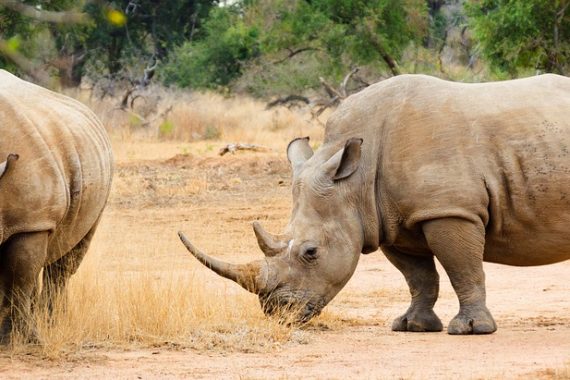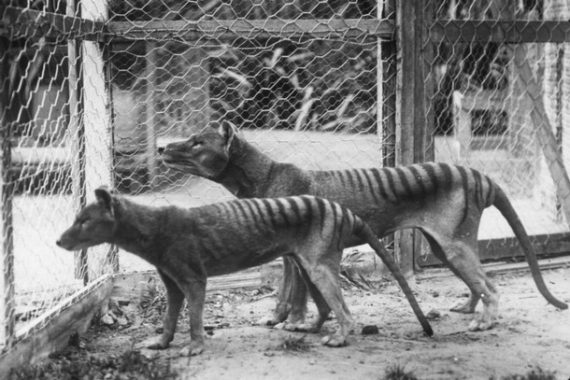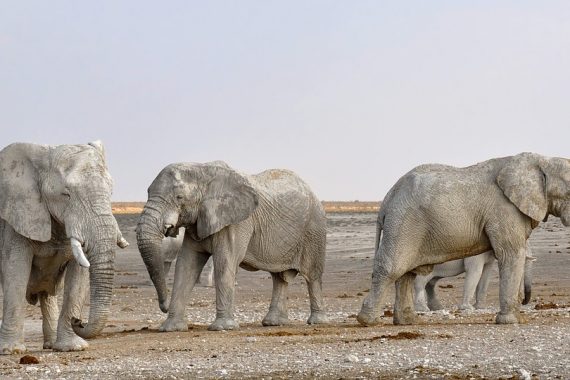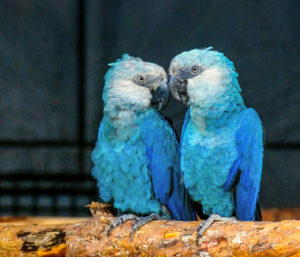
The beautiful blue Spix’s Macaw (image from www.science.org)
In the year 2000, the conservation world faced one of its biggest tragedies. The Spix’s macaw, a small, vibrant blue bird, was declared extinct, a victim of the prolific wildlife trafficking trade that is emblematic of Brazils’ struggle to conserve its biodiversity. But thanks to the hard work of dedicated conservationists, the Spix’s macaw is making a brilliant blue comeback! Maybe we can even give some kudos to the 29th Century Fox animated move Rio, which tells the story of the last male Spix’s macaw Rio and his trip to meet the female Jewel to escape trafficking and save their species, for raising awareness of this wonderful little parrots and its battle to survive in the human dominated world.
They are the only known species of the Cyanospitta genus and belongs to the order of New World long tailed parrots. When it was first seen by the earliest naturalists in the 1600s, it was believed to be the hyacinth macaw, but centuries later in the 1800s it was correctly recognized as a different species thanks to its small size and by the grey rings of skin around its eyes.
Their natural home is in the tropical dry forest Caatinga, a thorny habitat in the Northeast of Brazil that covers 10% of the country. For about 3 months, when the rains move in, the forest is lush and green, but for the rest of the year, the forest is a white and grey shadow of this wet season forest. In fact, Caatinga means ‘white forest’ in the language of the indigenous Tupi people. Once, the macaw used the hollows of old, desiccated Caraiba trees to nest in, leaving to forage for nuts, seeds and fruits, along with scraps of bark and cactus meat.
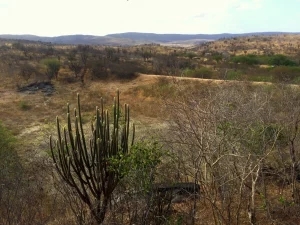
A shot taken from within the Caatinga, showcasing the typical flora (image from mongabay.org)
Feeling blue; the plight of the Spix’s Macaw
In the year 2000, the species was officially declared extinct in the wild. Already rare in the 1800s when it was named, centuries of deforestation, human interference and intensive grazing and logging of the Caatinga led to a dramatic decline in the 20th century. The Caraiba trees are slow growing and don’t regenerate well once destroyed, with no regrowth seen in logged areas for the past 50 years. In areas that could once have been reclaimed, climate change has led to the desertification of these areas, reducing any potential habitat for future restoration work. Although illegal trafficking of the bird for the pet trade was a massive problem, this intensive destruction of their habitat really doomed this bird almost to the history books, along with the dodo and the thylacine. In 1957, just when the birds were teetering on the brink of extinction, a hive of aggressive Africanized Honeybees escaped a research facility in Brazil and began spreading throughout the Caatinga region quickly, setting up homes in the same dry hollowed out trees the little parrot likes to set up house. They quickly outcompeted them for these very specific trees and attacked them whenever they tried to come close. In 1985, scientists quickly realized with horror that the macaw was almost gone from the dry forest it called home, and attempts were made to track populations and halt the decline, even though the species was legally protected by a new law introduced in 1967. In the late 90’s, several captive individuals were released into the wild, but quickly vanished and were never seen again. At least one female is believed to have died after collision with a power line, but it is suspected that the others were captured for the bird trade. Finally in 2000, after years of failed reintroductions and no further sightings, the Spix’s Macaw was declared extinct in the wild. Fortunately, since the sixties, the plight of the bird was recognized by the IUCN, and a captive breeding program was set up.
A conservation success story? Reversing the wild extinction of the Spix’s macaw
As of 2022, there are approximately 160 captive macaws held worldwide. Unfortunately, many of these birds have suffered from the health complications of inbreeding, chief among these being infertility and death in utero. Particularly challenging in a species we are trying to breed to keep their numbers up, many captive macaws suffer from delayed sexual maturity, and when they eventually reach reproductive age, they frequently produce unfertilized eggs, or infertile offspring. There are also reports from several vets of cardiovascular disease the likes of which have never been seen in parrots before. Not the kind of discovery you want to make in a bird that is clinging to existence by the very tips of its talons. To tackle some of these problems, assisted reproduction strategies like artificial insemination, are being utilized, although there have been mixed results.

All of the captive individuals alive today have descended from just seven birds, which are originally thought to have come from just two wild nests. Between 2000 and 2003, the Qatari Sheikh was instrumental in collecting several specimens of the Spix’s macaw, setting up the Al Wabra Wildlife Preservation and developing a studbook, the breeding history of a captive species, along with strict guidelines for husbandry and veterinary care. Most of the other captive individuals were housed in facilities in Brazil or in the hands of the Loro Parque Foundation, a zoo and conservation organization that has played a major role in the survival of twelve species which have had a brush with imminent extinction. Find out more about their wonderful conservation and research work at Loro Parque Fundación, We Care (loroparque-fundacion.org).
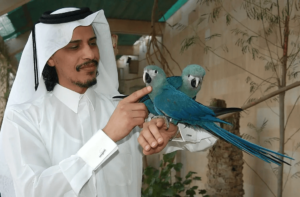
The late Qatari sheikh Saoud Bin Mohammed Al Thani spending time with the beloved parrots at the Al-Wabra Wildlife Preserve. (image from https://qataramerica.org/
In 2018, the reintroduction efforts began. Earlier in 2007, two farms totalling 2,780 hectares were bought in order to restore the vital habitat and Caraiba trees that would be so vital to support those plucky Spix’s macaw that had survived against all the odds. On the 11th June 2022, the first eight individuals were released into their large aviary in the heart of the Caatinga, and another 12 are scheduled to be released this month! (at the time of writing). From observations by watchful conservationists, the parrots are flocking together and flying well, evading predators with incredible aerial maneuvers. They are currently in the ‘soft release’ phase, regularly returning the large aviary where they lived for many moths while being prepared for their long-awaited return to their rightful, wild home. Much of the conservation efforts are spearheaded by the Spix’s Macaw Reintroduction Project, a not for profit organized by the charities Parrots International, the Association for the Conservation of Threatened Parrots and the Al Wabra Wildlife Preservation. Check out their amazing, groundbreaking conservation work at Spixs Macaw Re-Introduction Project – Spixs Macaw Association, and see the amazing impacts these conservation heroes are creating on the ground to breathe life back into this beautiful species. It is still early days for this bird, but if successful, it could pave the way for more reintroductions of species barely clinging to existence.
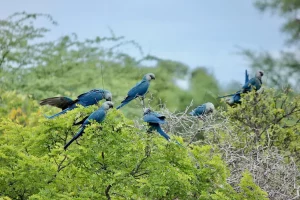
Spix’s macaws that have been re-released are starting to recolonise the Caatinga, bringing new hope for this beleaguered species (image from www.cbc.ca)
Awesome videos!
References
de Carvalho, M.P.N. Cunha, M.P.V. Knöbl, T. Cirqueira, C.S. Dias-Neto, R.N. Serafini, P.P. Catão-Dias, J.L. and Díaz-Delgado, J. (2021) ‘Cardiac disease in the Spix Macaw (Cyanopsitta spixii): two cases.’ Australian Veterinary Journal.
Fischer, D. Neumann, D. Purchase, C. Bouts, T. Meinecke-Tillmann, S. Wehrend, A. and Lierz, M. (2014) Zoo Biology
Hammer, S. and Watson, R. (2012) ‘The challenge of managing Spix Macaws at Qatar- an eleven year retrospective.’ Der Zoologische Garten
Spix’s Macaw return from extinction – Official Page (spixs-macaw.org)
Spix’s Macaw – Facts, Diet, Habitat & Pictures on Animalia.bio
Perl, J.M. (2005) ‘Spix’s Macaw: The race to save the world’s rarest bird.’ Common Knowledge
MASSIVE THANK YOU TO RACHAEL DA SILVA FROM THE UK FOR THIS WRITE UP! PLEASE FOLLOW HER ON INSTAGRAM AND HER WILDLIFE ARTWORK AT TILLY_MINT08


